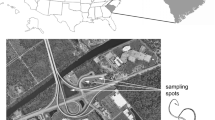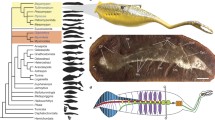Abstract
The Pterasteridae comprises a diversified group of extant largely deep-sea starfishes. Generic diagnoses have been based classically on soft tissue characters and skeletal architecture. A preliminary phylogeny of sixteen extant species is here worked out by cladistic analysis. The resulting tree suggests monophyly of extant genera and the validity of dissociated plates for identification of genera. Fossil remains of Pterasteridae are here described for the first time. By comparison with extant species, all the skeletal remains from the lower Upper Campanian of Belgium and from the lower Maastrichtian of Germany are tentatively assigned to the genusPteraster. The fossil record of starfishes is poor, but the present Late Cretaceous pterasterids provide one more piece of evidence of the high diversity of starfishes during the Mesozoic. Known Late Cretaceous and Paleogene fossils are broadly similar, which suggests the end-Cretaceous extinction event did not cause major turnover in asteroid faunal composition. As suggested for other starfish groups, both the fossil record of deep-sea Pterasteridae in shelf settings and tree topology imply an onshore-offshore evolutionary trend.
Kurzfassung
Bei den Pterasteridae handelt es sich um eine diversifizierte, heute überwiegend die Tiefsee bewohnende Gruppe von Seesternen. Die Gattungen werden klassischer Weise aufgrund von Merkmalen des Weichkörpers und der Skelettarchitektur unterschieden. Hier präsentieren wir eine vorläufige Phylogenie von 16 rezenten Arten. Die Ergebnisse der kladistischen Analyse lassen auf die Monophylie der rezenten Gattungen schließen. Außerdem wird der Wert isolierter Skelettplatten für die Identifizierung von Gattungen bestätigt. Zum ersten Mal werden hier fossile Überreste von Pterasteriden beschrieben. Durch Vergleiche mit rezenten Arten können alle Skelettreste aus dem unteren Obercampan von Belgien und aus dem Untermaastricht von Deutschland vorläufig der GattungPteraster zugeordnet werden. Die Fossilüberlieferung von Seesternen ist schlecht, jedoch belegen die kreidezeitlichen Pterasteriden einmal mehr die hohe Diversität der Seesterne während des Mesozoikums. Seesterne aus der Oberkreide und dem Paläogen sind einander sehr ähnlich, woraus sich schließen lässt, dass das K/T Aussterbeereignis keinen deutlichen „turnover“ in der Seesternfaunenkomposition bewirkt hat. Wie auch schon für andere Seestern-Gruppen vermutet, implizieren sowohl der Fossilbericht von Tiefsee-Pterasteriden in Schelf Sedimenten als auch die phylogenetische Beziehungen einen evolutiven onshore-offshore Trend.
Similar content being viewed by others
Literature
Blake, D.B. 1987. A classification and phylogeny of post-Palaeozoic sea stars (Asteroidea: Echinodermata). — Journal of Natural History21: 481–528.
Blake, D.B. 1990. Hettangian Asteriidae (Echinodermata: Asteroidea) from southern Germany: taphonomy, phylogeny and life habits. — Paläontologische Zeitschrift64: 103–123.
Blake, D.B. 1993. A new asteroid genus from the Jurassic of England and its functional significance. — Palaeontology36: 147- 154.
Blake, D.B. 1996. Redescription and interpretation of the asteroid speciesTropidaster pectinatus from the Jurassic of England. — Palaeontology39: 179–188.
Blake, D.B. &Hagdorn, H. 2003. The Asteroidea (Echinodermata) of the Muschelkalk (Triassic of Germany). — Paläontologische Zeitschrift77: 1–37.
Blake, D.B. &Reid, R. III. 1998. Some Albian (Cretaceous) asteroids (Echinodermata) from Texas and their paleobiological implications. — Journal of Paleontology72: 512–532.
Blake, D.B.;Tintori, A. &Hagdorn, H. 2000. A new, early crown-group asteroid (Echinodermata) from the Norian (Triassic) of Northern Italy. — Revista Italiana di Paleontologia e Stratigraphia106: 141–156.
Bless, M.J.M. 1988. Upper Campanian lithofacies and ostracode assemblages in South Limburg and NE Belgium. — In:Streel, M. &Bless, M.J.M., eds., The Chalk District of the Euregio Meuse-Rhine. Selected papers on Upper Cretaceous deposits: 57–67, Maastricht/Liège (Natuurhistorisch Museum Maastricht/Université d’État à Liège).
Bless, M.J.M. 1989. Event-induced changes in Late Cretaceous to Early Paleocene ostracode assemblages of the SE Netherlands and NE Belgium. — Annales de la Société géologique de Belgique112: 19–30.
Breton, G. &Vizcaïno, D. 1997. Astérides (Echinodermata) de l’Ilerdien (Yprésien) des Corbières (Aude, France): systématique, relations paléogéographiques et évolutives. — Bulletin de la Société d’Etude des Sciences de l’Aude97: 11–28.
Christensen, W.K. 1995.Belemnitella from the Upper Campanian and Lower Maastrichtian chalk of Norfolk, England. — Special Papers in Palaeontology51: 1–84.
Clark, A.M. 1996. An index of names of recent Asteroidea — Part 3. Velatida and Spinulosida. — In:Jangoux, M. &Lawrence, J.M., eds., Echinoderm studies5: 183–250, Rotterdam (Balkema).
Clark, A.M. &Downey, M.E. 1992. Starfishes of the Atlantic. — 794 p., London (Chapman and Hall).
Clark, H.L. 1920. Reports on the scientific results of the expedition to the Eastern Tropical Pacific, in Charge of AlexanderAgassiz, by the U.S. Fish commission steamer “Albatross” from October 1904 to Maren 1905, Lieut. Commander L.M. Garrett, U.S.N., commanding. Part 32. Asteroidea. — Memoire of the Museum of Comparative Zoology39 (3): 75–113.
Clarke, B. 1982. Die GattungCytherelloidea Alexander, 1929 (Ostracoda) im Schreibkreide-Richtprofil von Lägerdorf-Kronsmoor-Hemmoor (NW-Deutschland). — Geologisches JahrbuchA61: 35–71.
Fisher, W.K. 1911. Asteroidea of the North Pacific and adjacent waters. Part 1. Phanerozonia and Spinulosa. — United States National Museum Bulletin76: 1–404.
Gale, A.S. 1987. Phylogeny and Classification of the Asteroidea (Echinodermata). — Zoological Journal of the Linnean Society89: 107–132.
Hess, H. 1972. Eine Echinodermen-Fauna aus dem mittleren Dogger des Aargauer Juras. — Schweizerische Paläontologische Abhandlungen92: 1–87.
Jablonski, D. &Bottjer, D.J. 1990. Onshore-offshore trends in marine invertebrate evolution. — In:Ross, R.M. &Allmon, W.D., eds., Causes of evolution, a paleontological perspective: 21–75, Chicago (The University of Chicago Press).
Jagt, J.W.M. 1999. Late Cretaceous-Early Palaeogene echinoderms and the K/T boundary in the southeast Netherlands and northeast Belgium, Part 1. Introduction and stratigraphy. —Scripta Geologica116: 1–57.
Jagt, J.W.M. 2000. Late Cretaceous-Early Palaeogene echinoderms and the K/T boundary in the southeast Netherlands and northeast Belgium, Part 5. Asteroids. — Scripta Geologica121: 377–503.
Keutgen, N. &Jagt, J.W.M. 1999. Late Campanian belemnite faunas from Liège-Limburg (NE Belgium, SE Netherlands). — Geological Survey of Belgium, Professional Paper1998/2 (287): 1–31.
Knott, K.E. &Wray, G.A. 2000. Controversy and consensus in asteroid systematics: new insights into ordinal and familial relationships. — American Zoologist40: 382–392.
Maluf, L.Y. 1988. Composition and distribution of the Central Eastern Pacific Echinoderms. — Natural History Museum of Los Angeles County, Technical Reports2: 1–242.
Mooi, R. &David, B. 2000. What a new model of skeletal homologies teils us about asteroid evolution. — American Zoologist40: 326–339.
Mortensen, T. 1927. Handbook of the echinoderms of the British Isles. — 471 p., Oxford (Oxford University Press).
Niebuhr, B.;Volkmann, R. &Schönfeld, J. 1997. Das obercampanepolyplocum-Event der Lehrter Westmulde (Oberkreide, N-Deutschland): Bio-/Litho-/Sequenzstratigraphie, Fazies-Entwicklung und Korrelation. — Freiberger ForschungshefteC468: 211–243.
Reich, M. &Frenzel, P. 2002. Die Fauna und Flora der Rügener Schreibkreide (Maastrichtium, Ostsee). — Archiv für Geschiebekunde3: 73–284.
Sibuet, M. 1976. Le genreHymenaster (Astérides) dans l’Océan Atiantique. — Bulletin du Muséum National d’Histoire Naturelle, Paris (3)368: 305–324.
Simien, T.R. 1987. From coastal terrigenous deposits to pelagic-rich oozes: the Holocene transgressive complex of southern Belize Lagoon (CA.); a tool for the past? — Comparative Sedimentary Laboratory, University of Miami, Rosenstiel School of Marine and Atmospheric Sciences, Miami: 32–35.
Sladen, W.P. 1889. Report on the Asteroidea collected by the Challenger. — Scientific Reports of the Results of the Voyage of the Challenger, Zoology30: 1–894.
Swofford, D.L. 1993. PAUP, Phylogenetic Analysis Using Parsimony, Version 3.1.1. Copyright Smithsonian Institution.
Villain, J.-M. 1977. Le Maastrichtien dans sa région type (Limbourg, Pays-Bas). Étude stratigraphique et micropaléontologique. — Palaeontographica (A)157: 1–87.
Webster, G.D.;Hafley, DJ.;Blake, D.B. &Glass, A. 1999. Crinoids and stelleroids (Echinodermata) from the Broken Rio Member, Dyer Formation (Late Devonian, Famennian) of the White River Plateau, Colorado. — Journal of Paleontology73: 461–186.
Author information
Authors and Affiliations
Corresponding author
Rights and permissions
About this article
Cite this article
Villier, L., Blake, D.B., Jagt, J.W.M. et al. A preliminary phylogeny of the Pterasteridae (Echinodermata, Asteroidea) and the first fossil record: Late Cretaceous of Germany and Belgium. Paläont. Z. 78, 281–299 (2004). https://doi.org/10.1007/BF03009226
Received:
Accepted:
Issue Date:
DOI: https://doi.org/10.1007/BF03009226




